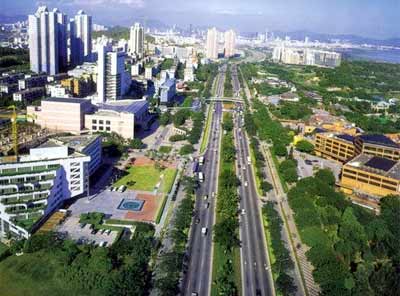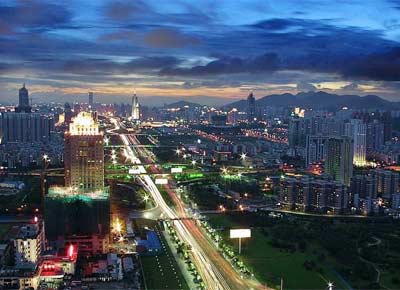In 2006 the Shenzhen Urban Management Bureau decided to renovate 35 roads and 2 bridges in three years using a fund of 1.5 billion yuan (about US$202 million). The total length of the roadway project encompassed 113.7 kilometers.
Shennan Road was listed as one of the 35 roads. The project began at the end of 2006 and ended in May 2007. The road's renovation set off a debate among local citizens, who hoped the government would go public regarding the cost of this particular road.
This November the other four roads in Shenzhen City: North Dongmen Road, Second Bagua Road, Beili Road and West Tianbei Road, began to be overhauled. Questions regarding the necessity of such road renovation have been raised again.
Some netizens have posted their points of view, stating that Shennan road was not in need of any repair. Maintenance transformed the cement road into an asphalt road to avoid unwanted noises, but there are few resident buildings around this road; hence this project was an absolute waste.
Government: the maintenances obey regulations
Jiang Lei, Director of the Road Management Office of the Road and Bridge Management Division in the Shenzhen Municipal Urban Management Bureau, said that the maintenance of these roads followed the official codes.
According to Jiang, Shennan Road was built on the base of G107 Road, constructed when the Shenzhen Special Economic Zone was founded in 1980. This road was only 2.1 kilometers long until it was extended to 50 meters in a project that lasted from 1982 to 1984. Then the road was extended twice, in 1985 and 1992 respectively. In 1997, when Hong Kong returned to the Chinese mainland, the road became Shenzhen's main road. At this time it was widened from six lanes to eight lanes; Shennan Road now became 28-kilometers-long and 140-meters-wide.
“The road has only been overhauled once in 1999,” he said. Moreover, because of the construction of a subway in Shenzhen, some sinks appeared along Shennan Road. The deepest pit was about one meter in depth.
According to the Road Maintenance Regulation enacted by the Construction Ministry, all roads that extend their designated allotted time should be overhauled and local road administration departments should formulate maintenance plans.
Jiang said that these regulations were published in the 1980s, but because of the lack of funds, no place except Hong Kong could follow through with effective maintenance work. The cost would have been more than 100 million yuan (about US$13.5 million) to do all necessary maintenance on all the required roads in Shenzhen. But the municipal government only allotted 50 to 60 million yuan (about US$6.7 to 8.1 million) to the Road and Bridge Management Department, he added.
Jiang explained that the Road and Bridge Management Department had made a bid for the Shennan Road renovation project. The Development and Reform Bureau discussed the issue and then approved it, after receiving all necessary official materials, including project applications, feasibility reports and a planning budget. “Given the authorized documents, we started to design the project. And then we turned over the drafts to the Bureau of Urban Planning and the Bureau of Construction. The bid was approved by Bureau of Audit,” Jiang said, adding that every procedure conformed to official regulations.
Taxpayers: need to know the whole budget
Zheng Xueding, a deputy to the municipal people's congress, noted that the footpath along the two sides of Shennan Road had been replaced with marble, adding great cost but little functional effect. He concluded that the funds used for construction were not all entirely necessary. He found the phenomenon of waste and luxury quite grave.
After the renovation project, the Shenzhen Urban Management Bureau invited hundreds citizens to visit the new road, including several deputies to the municipal people's congress. Xiao Youmei was one of them. During the tour he asked about the entire cost of the project and hoped that the government would go public with this information. Wu Zijun, Director of the Shenzhen Urban Management Bureau, responded that the cost was below the budget and the accounts had not been completely settled.
Then the focus settled on the footpaths and road curbs, which appear to be marble. The Bureau of Urban Management answered that it wasn't marble but granite, and that this same material is also used to construct the main roads in Shanghai and Nanjing.
But the explanation didn't satisfy the citizens. They retorted that concrete cement is cheap and solid enough. Granite is quite costly for footpaths and road curbs, plus after it rains these footpaths would become too slippery to walk on it.
Viewpoint: when to repair the decision-making procedure?
Whether it's worth while to pay dozens of millions yuan just for a beautiful city is at heart of the controversy.
Apparently, the Shennan Road overhaul was not just a functional repair job. The Shenzhen government wanted to make the road a symbol of the city. Some people supported the government in creating such a scenic city road. Fang Shou'en, a professor of Tongji University, argued that scenic roads also existed in Shanghai, Beijing and Xi'an.
Taking the above into consideration, the renovation project seems reasonable. But the root of the problem really revolves around governmental decision-making procedures.
Whether Shennan Road should be repaired or not, how to repair it -- all of these questions are public affairs management issues. But so far Shenzhen locals have been given no right to decide anything about such maintenance project. In Shenzhen the public supervision consciousness has indeed improved swiftly but the decision making system is still outmoded, according to Ma Jingren, a professor of Shenzhen University.
The current system has the power to choose many luxurious city planning projects that waste taxpayers' money.
(China.org.cn by Chen Lin December 15, 2007)



